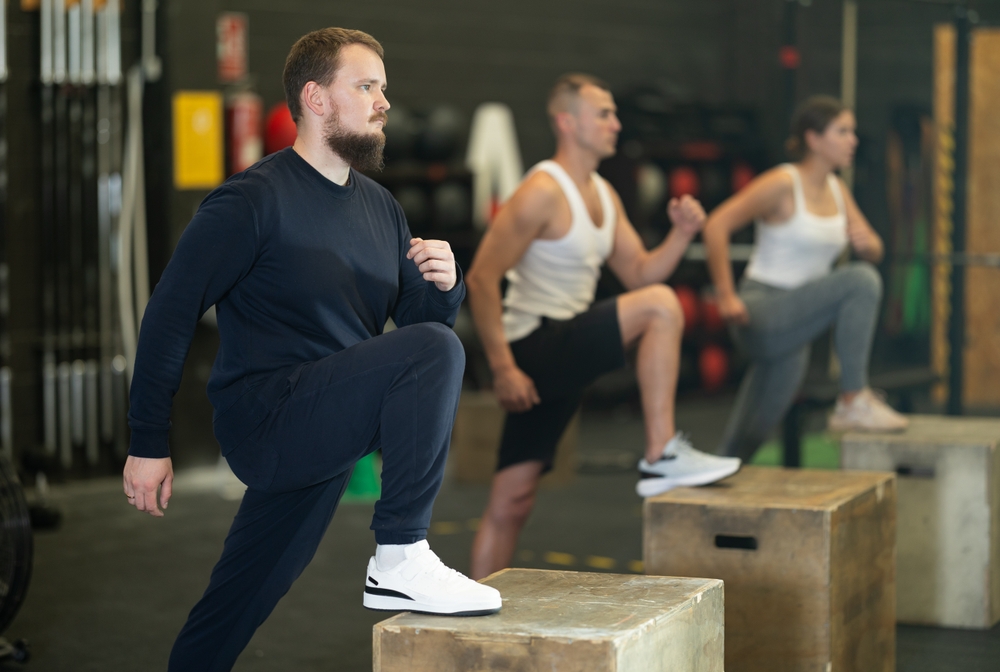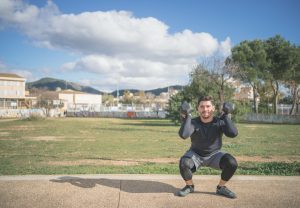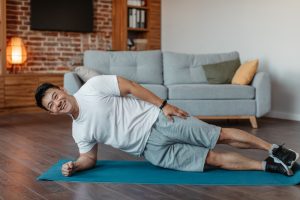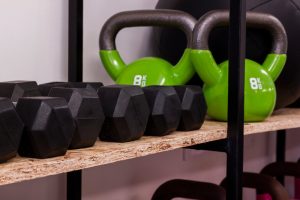High step-ups are one of the most effective exercises for building glute size and strength—if you do them correctly.
To get the most out of them, use a knee-height platform, drive through your front heel without pushing off your back leg, and fully extend your hip at the top.
Keep reading for a detailed breakdown of form, technique cues, and ways to progress safely.
Why High Step-Ups Are So Effective for Glute Growth
If your goal is to build stronger, more developed glutes, high step-ups deserve a permanent spot in your lower-body routine.
They do more than just activate the glutes—they isolate and challenge them in ways that most compound movements can’t match.
Unlike exercises like squats or deadlifts that share the load across multiple joints and muscle groups, high step-ups force the glutes to do more of the heavy lifting.
That’s especially true when you use proper form: stepping high, leaning slightly forward, and driving through the heel of your working leg.
This position places your gluteus maximus in an ideal stretch at the bottom and demands full contraction at the top.
What really sets the step-up apart is its unilateral nature—you’re working one leg at a time.
This matters for a few key reasons:
- Improved muscle symmetry: Most people have a dominant leg that takes over during traditional lower-body lifts. Step-ups help even that out by isolating each side.
- Increased core engagement: Since you're balancing on one leg while moving vertically, your core works overtime to stabilize your spine and pelvis.
- Enhanced joint stability: The single-leg focus improves ankle, knee, and hip control, which benefits everything from running mechanics to heavy barbell lifting.
Another major benefit is how functional this movement is.
High step-ups mimic real-world tasks—like climbing stairs or hiking uphill—which means the strength you build here directly translates to daily activities or sports performance.
That’s a win not just for aesthetics but for movement quality and injury prevention, especially if you’re prone to compensation patterns or lower-body imbalances.
When it comes to glute activation, step-ups consistently outperform other lower-body staples in EMG studies.
What this means in simple terms is that your glutes are more active—and more likely to grow—when step-ups are programmed and executed correctly.
So if you’ve hit a plateau with squats, deadlifts, or hip thrusts, or you’re simply looking to refine your glute development, high step-ups offer a uniquely powerful way to target the glutes without needing heavy loads or machines.
How to Set Up for High Step-Ups (Without Hurting Your Knees or Wasting Glute Tension)
Proper setup is what makes or breaks the high step-up.
If you start with the wrong step height or body position, you’re either offloading the glutes or putting your joints at risk.
Dialing in a few key setup details ensures that the movement stays glute-dominant, safe, and effective.
The most important factor is step height.
Aim for a platform that brings your front thigh to about parallel with the floor—or slightly above—when your foot is placed on it.
For most people, this means a box or step that’s roughly knee height. If the platform is too low, you’ll get limited range and less glute involvement.
If it’s too high, your form is more likely to break down, especially if you’re not mobile or strong enough to maintain good control at the bottom.
Once you’ve got the height right, position your body before the first rep.
Your feet should be hip-width apart when you’re standing on the ground, and your toes should be pointing straight ahead.
This sets up proper alignment and makes it easier to stabilize as you step up.
Engage your core and spine next.
Brace your abs as if you’re about to take a light punch to the stomach, and keep your spine neutral—no rounding or excessive arching.
That bracing gives your hips something stable to work from, which is key for glute engagement and protecting your lower back.
When you step up, stand close enough to the platform that you don’t have to reach your foot forward or stretch to make contact.
Reaching too far throws off your balance and can cause you to lean too much or shift load into the wrong muscles.
Keep your shoulders set but relaxed—pulled slightly back and down without flaring the ribs.
This small posture adjustment helps maintain upper-body alignment and prevents excessive arching as you lift.
All these setup elements are easy to overlook, but they directly impact how much tension your glutes experience—and how much strain your knees or lower back might absorb.
Get them right from the beginning, and every rep becomes more efficient and productive.
Step-by-Step Technique: Form Breakdown That Actually Builds Glutes
Executing high step-ups with proper form is what separates real glute growth from wasted reps.
Each phase of the movement—setup, drive, extension, and descent—needs to be intentional.
When you rush through any part or lose focus on your mechanics, you shift tension away from the glutes and start relying on joints or secondary muscles to do the work.
Start with how you place your front foot.
The entire foot must be flat and fully planted on the step—no heel hanging off or toe-only contact.
This stable base lets you drive force through your heel, which is what lights up the glute and protects the knee from taking on too much load.
From there, initiate the movement with a slight forward lean.
This subtle shift tilts your torso just enough to direct tension into your glutes without turning it into a hip hinge.
Keep your chest lifted and spine neutral while maintaining that lean—too much forward angle and you lose control; too little and your quads take over.
As you step up, drive through the heel of your lead leg, not your toes or your back leg.
The back foot should either hover or lightly tap the ground—not push off. If your rear leg is helping, even a little, you're missing the point of the exercise.
At the top, don’t just stand up—extend your hip fully.
Thrust your hips forward and squeeze your glute intentionally to create a straight line from your shoulders through your back heel.
This conscious glute contraction is where a lot of people miss the most important part of the movement.
The descent matters just as much. Don’t let gravity pull you down.
Lower yourself slowly and under control, keeping tension in your glute the entire time.
The eccentric (lowering) phase is actually one of the most powerful drivers of muscle growth when done deliberately.
A strong glute-focused tempo might look like this: 4 seconds down, 2-second pause at the bottom, 4 seconds up.
This extended time under tension increases recruitment, boosts control, and helps prevent momentum from stealing the load.
Finally, for better results and stronger mind-muscle connection, do all your reps on one leg before switching sides.
This repetition strategy allows your body to stay focused, balanced, and fatigued in a controlled way without resetting your position on every rep.
Every part of this movement builds on the last.
Rush one, and you compromise the next.
Stay present, keep your form tight, and let the tension do its job.
Key Technique Cues to Keep Tension in the Right Muscles
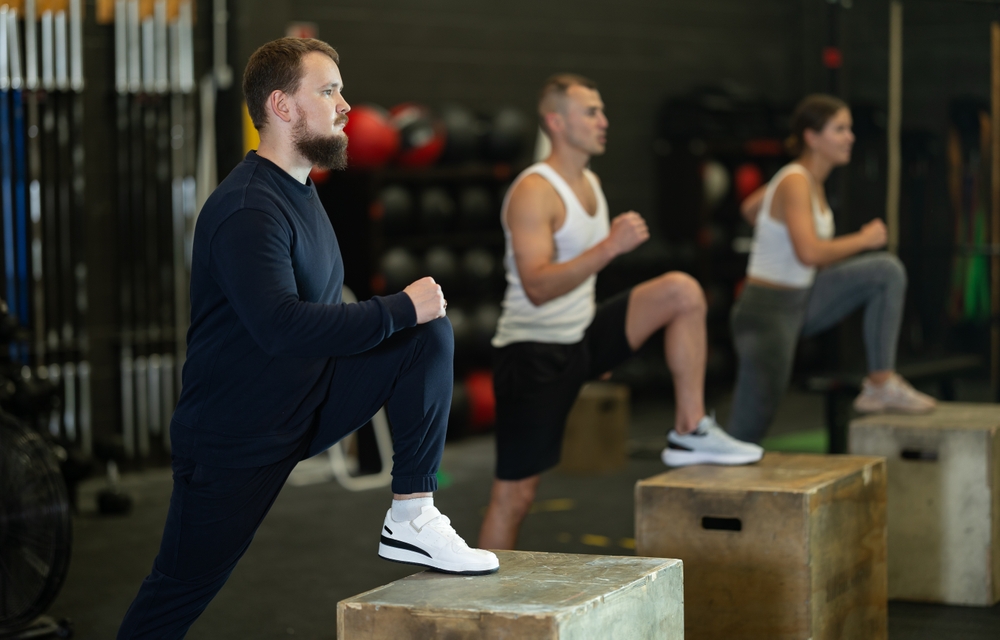
Even with a solid setup and step-by-step approach, the quality of your reps can still fall apart if you’re not dialed into the right cues.
Small adjustments in focus and alignment can be the difference between a glute-dominant step-up and one that turns into a quad-heavy or joint-stressing grind.
These cues help you stay locked into the right mechanics and keep the glutes doing the work from start to finish.
The first cue to keep in mind is heel pressure. Every rep should be powered by pushing through the heel of your front foot.
If you find yourself driving through the ball of your foot or letting your toes take over, you’re shifting load away from the glute and toward the knee.
It also becomes easier to sneak in a push from the back leg—something that will dramatically reduce glute activation without you realizing it.
Keep a slight forward lean in your torso as you move.
This isn’t a bend at the waist or a chest drop—it’s more like a subtle hinge from the hips that shifts your center of gravity just enough to help the glute take on the load.
If you stay completely upright or lean too far forward, you either under-load the glute or start compensating with your lower back and hamstrings.
Core engagement and spinal alignment are also critical.
A braced core helps maintain a neutral spine, which keeps your pelvis stable and reduces the chance of compensation through your lumbar spine.
You don’t need to over-squeeze your abs—just keep your ribcage tucked slightly and avoid overarching or slouching.
Glance at your knee tracking mid-rep.
The working knee should move in line with your foot—never collapsing inward or drifting out.
If you notice wobbling or a loss of alignment, it could be a sign that your glute medius isn’t stabilizing effectively or that you're fatigued.
Reset if needed rather than continuing with poor mechanics.
To reinforce precision and eliminate momentum, build in a pause at both the top and bottom of each rep.
Holding for a second or two at the bottom ensures you’re not bouncing out of the position, while a pause at the top lets you confirm full hip extension and glute contraction.
These small moments of control increase time under tension and help lock in better form over time.
Together, these cues don’t just clean up your technique—they help you build stronger neuromuscular connections to your glutes.
That means more growth, less joint strain, and a movement that actually delivers on its promise.
Performance Tips and Variations to Progress Without Plateauing
Once you’ve nailed the basics, step-ups can evolve into an incredibly versatile tool for long-term glute development.
But like any movement, progress stalls if you keep repeating the same version without making adjustments.
To keep growing stronger and more stable glutes, you’ll need to challenge the movement strategically—with better control, added resistance, and smart variation.
If balance is holding you back early on, use a support like a wall, railing, or light object for stability.
The key is to touch lightly—just enough to prevent wobbling. This allows you to focus on glute control without overcompensating or rushing through reps.
As your balance improves, wean off the support gradually until your body handles the entire load independently.
From there, the most straightforward way to increase difficulty is to add external resistance.
Start with bodyweight only until your form is rock solid. Then, introduce dumbbells held in front of your body—this placement also promotes better posture and core activation.
As you get stronger, kettlebells or even a barbell can be used, but only if you can maintain the same form under load.
However, progression isn’t just about adding weight.
One of the most effective ways to intensify the glute demand is to increase the height of the step.
A higher platform boosts the range of motion, stretching the glute at the bottom and forcing a more complete contraction at the top.
Just make sure your joints stay aligned and you can still drive through the heel without collapsing your posture.
To prevent adaptation and boredom, rotating through step-up variations is a smart way to expose your muscles to new stimuli:
- Lateral step-ups shift the plane of motion and place more emphasis on the gluteus medius and minimus. These are the side glute muscles responsible for hip stability and shape.
- Step-ups with a knee drive at the top add a dynamic balance and core challenge, especially if done slowly and under control.
- Crossover or chop step-ups bring in a rotational component, training your body to stabilize and produce force in multiple directions—ideal for athletes or anyone looking to improve functional strength.
No matter the version, stay strict with tempo and form.
The more control you maintain, the more effective the movement becomes.
Rather than chasing heavier weights too soon, focus on small, deliberate changes that build strength without sacrificing glute tension or joint health.
That’s how you avoid plateaus and keep your progress moving forward.
How to Program Step-Ups for Maximum Glute Development
Getting the most out of step-ups isn’t just about form—it’s also about how you fit them into your overall training plan.
When programmed strategically, they can deliver significant strength and hypertrophy gains without needing constant variation or high volume.
For hypertrophy-focused results, 3–4 sets of 6–12 reps per leg is a solid range to aim for.
This keeps intensity high enough to promote growth while still giving you room to focus on tempo, form, and fatigue management.
If you're newer to unilateral training or still refining your control, stick to the higher end of the rep range with lighter load or bodyweight.
As your strength improves, dropping to 6–8 reps with added resistance can drive more overload.
Tempo matters just as much as load.
Emphasize the eccentric phase—the lowering portion of the rep—by slowing it down to around 4 seconds.
Add a pause at the bottom to eliminate bounce, then drive up with control.
These deliberate movements keep your glutes under tension longer and encourage better muscle fiber recruitment.
That’s especially important with bodyweight versions, where intensity has to come from control rather than load.
When it comes to frequency, 2–4 times per week is a practical guideline.
If you're doing full-body training or glutes are a secondary goal, twice a week may be enough.
If glute development is a top priority, adding more frequent but varied step-up sessions—at different heights, loads, or tempos—can help increase training volume without burning out any one pattern.
To support step-up progress and overall glute growth, layer them alongside complementary glute-focused movements.
Pair them with hip thrusts, glute bridges, cable kickbacks, or abduction work to target the full spectrum of glute function and fiber types.
Step-ups target the glute max especially well, but other exercises help round out the medius and minimus, which contribute to shape, posture, and pelvic control.
One overlooked but highly effective tactic is to use bodyweight step-ups or glute bridges as activation drills at the start of your workout.
These low-load versions “wake up” the glutes by reinforcing neuromuscular connection, making sure they're firing before you move into heavier lifts.
Just 1–2 sets of 10–15 controlled reps can prime your system and make the main work more productive.
Ultimately, programming step-ups is about matching volume, intensity, and frequency to your current level and broader goals.
Keep it consistent, focus on progression, and let your glutes do the work.
Conclusion
High step-ups are one of the most effective ways to build stronger, more balanced glutes—when executed with the right setup, form, and intent.
By controlling tempo, progressing strategically, and programming them alongside other glute-focused work, you can turn them into a long-term staple for development.
Stay consistent, keep the tension where it belongs, and the results will follow.

